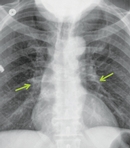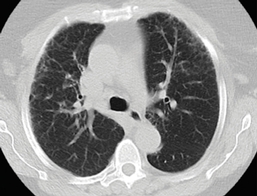Marijuana Smoking may be More Harmful than Tobacco
Thursday, Nov. 30, 2017

Parnes
As of 2017, eight states and Washington D.C. have legalized recreational marijuana use, and 29 states have legalized its medicinal use. "With increased legalization, there is likely to be a greater number of related health problems, and radiologists must become familiar with the clinical effects of marijuana abuse," said Benjamin Parnes, a fourth-year medical student at State University New York (SUNY) Downstate.
In his digital Education Exhibit, Parnes reviewed clinical symptoms found in chronic marijuana smokers and demonstrated common imaging manifestations related to pathophysiological effects seen in patients who abuse marijuana. "Certain clinical symptoms like euphoria, conjunctival injection and increased appetite are expected, but chronic users may also have anxiety, paranoid delusions and hallucinations," Parnes said.
Deep inhalation and extended hold of marijuana smoke can have a significant cellular impact and lead to thermal injury and carcinogenic effects which may potentially be more harmful than tobacco smoking. "The extended hold leads to an increase in the absorption of tetrahydrocannabinol (THC), and users are subject to a greater deposition of tar and carcinogens in the airway," Parnes said.
Similar to tobacco, marijuana smoking injures the respiratory epithelium and kills ciliated epithelial cells. It can deliver nearly twice the amount of benzopyrene, the most common of the polyaromatic hydrocarbons (PAC) known to cause cancer, as well as nearly 75 percent more benzanthracene than tobacco smoking. Among the endobronchial biopsy findings related to marijuana use are goblet cell metaplasia, reserve cell hyperplasia and squamous cell metaplasia.
Imaging studies presented by Parnes demonstrated a wide range of clinical findings associated with chronic marijuana use including a synergistic emphysema that occurs when marijuana is used with tobacco, bronchitis and bronchiolitis, carcinogenic effects contributing to the development of lung cancer, invasive aspergillosis in immunocompromised patients, trauma and interstitial lung disease.

PA and lateral CXR demonstrating peribronchial thickening, consistent with chronic bronchitis. (Click or tap to view larger)
One study showed a mild displacement fracture of the left mandibular coronoid process on a 39 year-old man with a history of marijuana use. "We think of marijuana as creating a euphoria, but it can also lead to cannabis-induced psychosis and an increase in violent crimes. That's where we see trauma injuries," Parnes said.
Also on the rise is the use of synthetic marijuana which when abused, according to Parnes, is associated with pneumonia, airway collapse, airway disease and aspiration. The side effects associated with synthetic marijuana are similar to natural marijuana but may also include hypertension, myocardial ischemia, vomiting and aggression.
"The synthetic product is cheaper than natural cannabis, is not detected in standard drug tests, has questionable legal status and is often sold in gas stations and stores that carry drug-related paraphernalia," he said.
Despite its risks, marijuana has proven effective in a variety of clinical uses including, but not limited to, acting as an antiemetic in patients undergoing chemotherapy and serving as an appetite stimulant in patients with AIDS.
"Because there is an overlap with marijuana and cigarette smoking, we consider the findings of this study 'non-specific'," Parnes said. "However with increased legalization of the drug, over time we will be able to gather more marijuana-specific data."

Chest CT demonstrating peripheral reticular and ground glass opacities with bronchiectasis, consistent with non-specific interstitial lung disease.(Click or tap to view larger)




 Home
Home Program
Program
 Exhibitors
Exhibitors My Meeting
My Meeting
 Digital Posters
Digital Posters Case of Day
Case of Day

